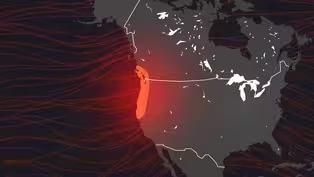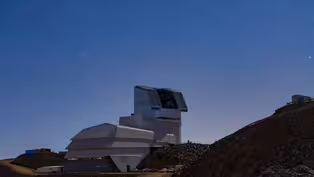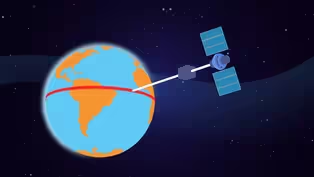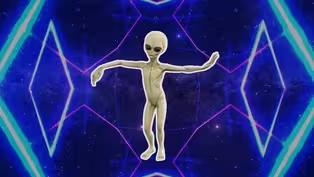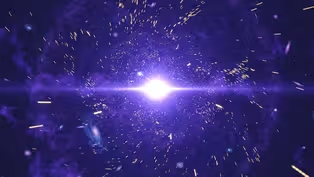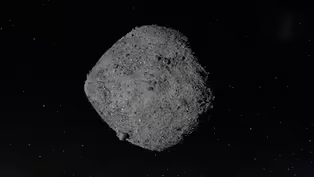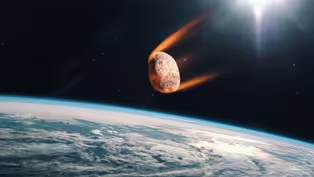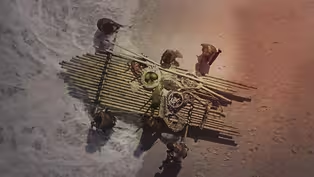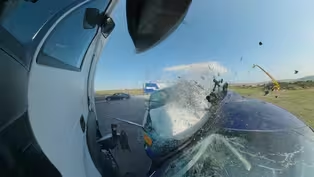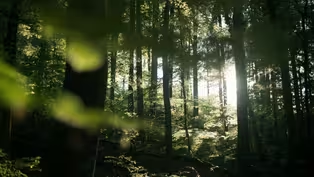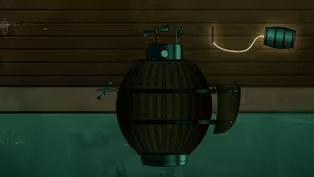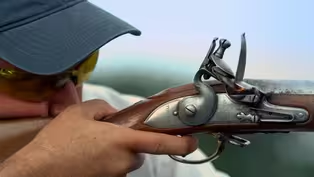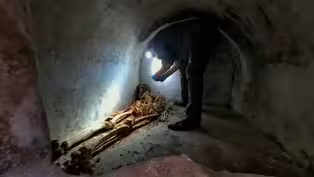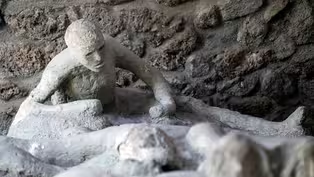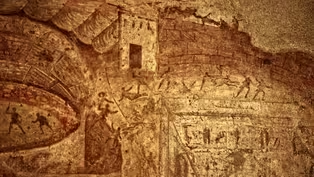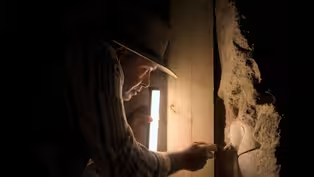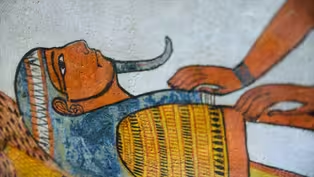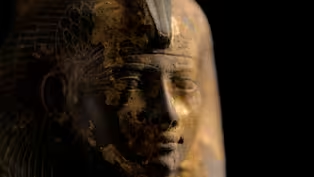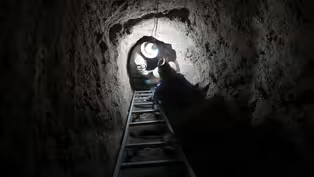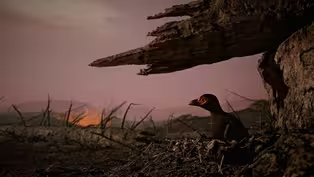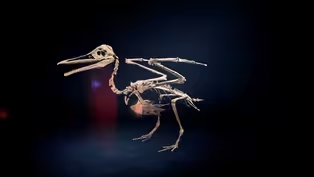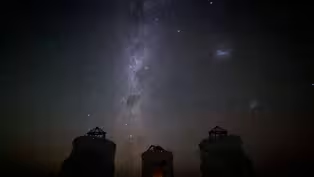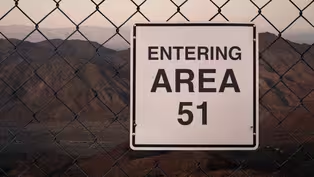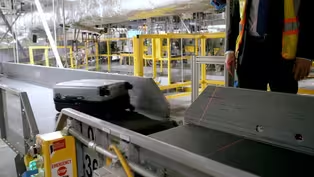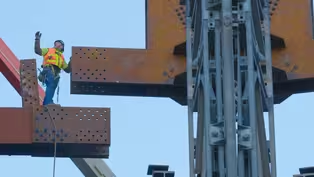
Building Blocks of Life Discovered on Distant Asteroid
Clip: Season 52 | 6m 3sVideo has Closed Captions
Scientists have discovered the building blocks of life in samples retrieved from a distant asteroid.
In January 2025, scientists announced the discovery of organic molecules— the building blocks of life— in samples retrieved from a distant asteroid named Bennu. What can this discovery reveal about the secrets of life's origins? Or how common life may be elsewhere in the universe?
Problems playing video? | Closed Captioning Feedback
Problems playing video? | Closed Captioning Feedback
National Corporate funding for NOVA is provided by Carlisle Companies. Major funding for NOVA is provided by the NOVA Science Trust, the Corporation for Public Broadcasting, and PBS viewers.

Building Blocks of Life Discovered on Distant Asteroid
Clip: Season 52 | 6m 3sVideo has Closed Captions
In January 2025, scientists announced the discovery of organic molecules— the building blocks of life— in samples retrieved from a distant asteroid named Bennu. What can this discovery reveal about the secrets of life's origins? Or how common life may be elsewhere in the universe?
Problems playing video? | Closed Captioning Feedback
How to Watch NOVA
NOVA is available to stream on pbs.org and the free PBS App, available on iPhone, Apple TV, Android TV, Android smartphones, Amazon Fire TV, Amazon Fire Tablet, Roku, Samsung Smart TV, and Vizio.
Buy Now
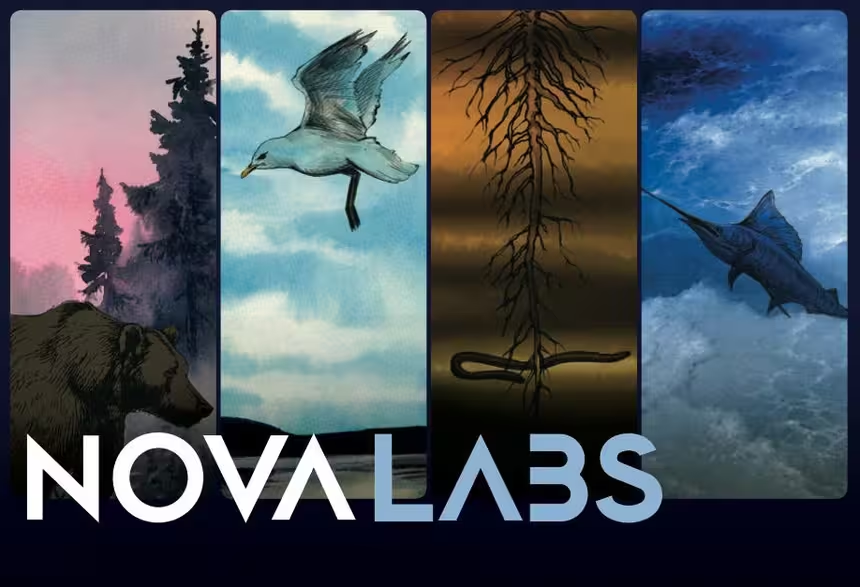
NOVA Labs
NOVA Labs is a free digital platform that engages teens and lifelong learners in games and interactives that foster authentic scientific exploration. Participants take part in real-world investigations by visualizing, analyzing, and playing with the same data that scientists use.Providing Support for PBS.org
Learn Moreabout PBS online sponsorship- [Narrator] How did life originate on earth?
Science may be getting closer to providing an answer.
In January, 2025, researchers announced the discovery of organic molecules, the building blocks of life, in samples retrieved from a distant asteroid.
- [Marc Buie] It's profoundly exciting.
This is really eyeopening to me.
- [Dante Lauretta] It was a dream come true.
All of those years, decades of planning, implementing, and ultimately, delivering a sample back to the earth have paid off.
- [Narrator] The samples were first retrieved in 2020, during NASA's OSIRIS-REx Mission.
The spacecraft traveled 1.2 billion miles to an asteroid called Bennu, and briefly touched its surface to gather samples of rocks and dust.
(dramatic music) A capsule containing the samples returned to Earth in 2023, safely landing in a Utah desert.
- [Dante] And it was like seeing an old friend that had gone away seven years ago, come back a little bit rough and worse for wear, but carrying this amazing treasure from outer space.
- [Narrator] Analyzing the samples, researchers have discovered thousands of different kinds of organic molecules- molecules that generally contain both carbon and hydrogen- including 14 types of amino acids that cells on Earth use to build proteins, and the four nucleobases found in DNA.
You know, those G's, C's, A, and T's.
Plus, an additional nucleobase we see in RNA.
- [Marc] With the OSIRIS-REx results, we see that we have these building blocks, that's very exciting.
- [Dante] Scientists have been analyzing meteorites, which are fragments of asteroids that land on the surface of the Earth, looking for these compounds for decades now, and we found them.
We have found amino acids in meteorites, hints of nucleobases, the genetic code letters, but the results were always suspect, because we know that as soon as a meteorite lands on earth, it gets contaminated.
So you can never prove it.
You could never prove that these molecules came from outer space, and that is why we had to go and get it straight from the source itself.
- [Narrator] But how could there be organic materials on an asteroid?
Research suggests that Bennu, now only a third of a mile wide, may once have been part of a much larger object, possibly more than a hundred miles wide.
In the frigid reaches of the outer solar system, where Bennu's parent body is suspected to have formed, it would've received very little heat from the sun.
But scientists think that its interior could have remained relatively warm, possibly between 68 and 84 degrees Fahrenheit, thanks in part to an ongoing decay of radioactive elements inside.
We're learning that water is, and has been, very abundant in the solar system.
So deep in the parent asteroid, water ice could have melted into a salty brine.
Over time, allowing compounds like ammonia, formaldehyde, and other molecules to react to form organic molecules like amino acids and nucleobases.
- [Dante] So, by analyzing structures at the minuscule level, the molecular level, we can piece together this grandiose story of a water rich, maybe ocean world forming out beyond Saturn, and over billions of years migrating into inner space, getting shattered, producing the fragments that went into create Bennu.
- [Marc] You can glean so much from the chemistry, how this all relates back to the origin story.
- [Narrator] Scientists believe these findings could help explain how life may have developed in our solar system, as well as give us clues about life's prospects elsewhere.
- [Anjali Tripathi] The prospects for life, I'd say throughout the universe are really exciting and really good, because there are so many places where it looks like you might have all of the right ingredients, and it's just a matter of what it takes to put them together.
- And what we're seeing is the molecules that make up the most fundamental structures in biology, proteins, nucleic acids, genetic code, they're common.
They seem to be everywhere in the early solar system.
And these carbon rich asteroids delivered them not only to the early Earth, but to Venus and to Mars, to the moons of Jupiter and Saturn and beyond.
So we don't know if there's life in any of those locations, although we've got tantalizing clues that there might be, underneath the surface of Mars, in the deep oceans of Europa and Enceladus, these icy satellites of the outer solar system, and at least we know they had a chance.
They got the basic building blocks.
What we don't understand yet, and I think one of the greatest mysteries in science, is how do you take that menagerie of molecules and turn it into something that's alive?
- [Narrators] Researchers will continue to study the Bennu samples, trying to uncover further secrets of life's early remnants.
- [Dante] What's even more exciting is we're really just getting started.
This is the first suite of organic analyses.
We brought back a lot of material and there's a lot more exciting results to come.
- [Marc] I think we need many different kinds of studies to answer the question about what's going on for the origin of the solar system, the origin of life.
I'm sure that there's a role for additional sample return missions.
I think an interesting question would be, which target would you go to for the next one?
- [Anjali] It is really exciting to think about what we'll find, because whether we find that we're alone or that we aren't, right?
It's really profound either way, and I think we always get really hung up on the we must find life, but if we don't find life and we're finding the ingredients for it everywhere, that's also a really interesting question.
- Everything in the solar system connects to the question of life, it's just a question of degree, and that's a very exciting thing.
(dramatic music)
The Next Big Earthquake Could Sink Parts of the Pacific Northwest
Video has Closed Captions
Clip: S52 | 5m 8s | A massive earthquake along the Cascadia Subduction Zone could sink parts of the Pacific Northwest. (5m 8s)
How Harvard Discovered It Has an Original Copy of the Magna Carta
Video has Closed Captions
Clip: S52 | 3m 13s | They paid only $27.50 for it from a London bookseller in 1946. (3m 13s)
This Giant Telescope Will Reveal The Universe in Unbelievable Detail
Video has Closed Captions
Clip: S52 | 5m 59s | Go behind the scenes as NOVA visits the Vera Rubin Observatory in Chile. (5m 59s)
The Science of Scratch-Offs: What Your Brain Can’t Resist
Video has Closed Captions
Clip: S52 | 6m 39s | You probably won’t win big playing the Lottery but your brain may want to keep trying. (6m 39s)
These Smart Glasses Know Who You Are, and Much More
Video has Closed Captions
Clip: S52 | 4m 18s | Two students created glasses that can identify people on the street, without them knowing. (4m 18s)
The Rocket-Less Future of Space Travel
Video has Closed Captions
Clip: S52 | 5m 17s | Space elevators? Nuclear rockets? The future of space travel could look radically different. (5m 17s)
Do Aliens Exist? This Famous Equation Offers a Clue
Video has Closed Captions
Clip: S52 | 5m 4s | The Drake Equation helps scientists estimate the odds of finding intelligent alien civilizations. (5m 4s)
Video has Closed Captions
Clip: S52 | 5m 7s | If the universe as we know it started with the Big Bang, will it also have an end? (5m 7s)
Building Blocks of Life Discovered on Distant Asteroid
Video has Closed Captions
Clip: S52 | 6m 3s | Scientists have discovered the building blocks of life in samples retrieved from a distant asteroid. (6m 3s)
This Asteroid Might Make Impact With Earth in 2032
Video has Closed Captions
Clip: S52 | 3m 33s | An asteroid is on a collision course with Earth, possibly making impact in 2032. (3m 33s)
Human: Building Empires Preview
Video has Closed Captions
Preview: S52 Ep16 | 30s | Discover how two revolutionary ancient inventions changed the course of humanity forever. (30s)
Human: Into the Americas Preview
Video has Closed Captions
Preview: S52 Ep15 | 30s | Follow ancient humans’ journey into an icy and perilous new land. (30s)
Human: Neanderthal Encounters Preview
Video has Closed Captions
Preview: S52 Ep14 | 30s | Discover how Homo sapiens outlasted Neanderthals – and how they helped make us who we are today. (30s)
Video has Closed Captions
Preview: S52 Ep13 | 30s | Follow Homo sapiens as they venture out of Africa and spread farther than any other human species. (30s)
Video has Closed Captions
Preview: S52 Ep12 | 30s | Trace the remarkable origin story of Homo sapiens and the crucial moments that shaped our species. (30s)
Ultimate Crash Test: Countdown Preview
Video has Closed Captions
Preview: S52 Ep10 | 30s | A first-of-its-kind experiment aims to stage a multi-vehicle pileup to gain new data on car safety. (30s)
Critical Condition: Health in Black America Preview
Video has Closed Captions
Preview: S52 Ep9 | 30s | After centuries of pseudoscience, researchers examine the causes of racial health disparities. (30s)
Why Just Planting Trees Won’t Save the Planet
Video has Closed Captions
Clip: S52 Ep8 | 3m 4s | Could restoring lost forests help slow climate change? (3m 4s)
Video has Closed Captions
Preview: S52 Ep8 | 30s | Follow scientists in a quest to understand how complex forest ecosystems can help cool our planet. (30s)
The World’s First Combat Submarine
Video has Closed Captions
Clip: S52 Ep7 | 10m 49s | Its nickname was the “Turtle”. (10m 49s)
Revolutionary War Weapons Preview
Video has Closed Captions
Preview: S52 Ep7 | 30s | Explore key military technologies in the American colonies’ fight for freedom. (30s)
Video has Closed Captions
Clip: S52 Ep7 | 4m 57s | A team of experts put an 18th-century musket to the test — revealing how deadly it really was. (4m 57s)
What Went Wrong on the Dali Before the Baltimore Bridge Collapse
Video has Closed Captions
Clip: S52 Ep6 | 2m 57s | The container ship Dali lost power causing it to crash into Baltimore’s Key Bridge. (2m 57s)
What Caused Baltimore’s Key Bridge to Collapse?
Video has Closed Captions
Clip: S52 Ep6 | 2m 57s | Engineers explain how a vulnerability made the bridge open to catastrophe. (2m 57s)
Baltimore Bridge Collapse Preview
Video has Closed Captions
Preview: S52 Ep6 | 30s | Follow the investigation into the deadly container ship collision that closed the Port of Baltimore. (30s)
This Pompeii Priest Had an Unexpected Rise to Power
Video has Closed Captions
Clip: S52 Ep5 | 2m 58s | In a recently discovered tomb in Pompeii, archeologists made a startling discovery. (2m 58s)
Pompeii's Secret Underworld Preview
Video has Closed Captions
Preview: S52 Ep5 | 30s | Archaeologists uncover new truths about Pompeii, a wealthy Roman playground with dark secrets. (30s)
A Brutal Gladiator Fight in Ancient Pompeii
Video has Closed Captions
Clip: S52 Ep5 | 2m 37s | At a gladiator match in ancient Pompeii, tensions exploded and spectators became fighters in a riot. (2m 37s)
What's Inside These Ancient Egyptian Jars?
Video has Closed Captions
Clip: S52 Ep4 | 1m 58s | A nearly 3,000-year-old canopic jar is discovered in an Egyptian tomb. (1m 58s)
Opening a Sealed Egyptian Tomb
Video has Closed Captions
Clip: S52 Ep4 | 2m 38s | Archaeologists remove the mud brick seal of an unopened Egyptian tomb. (2m 38s)
How the Afterlife Shaped Ancient Egypt
Video has Closed Captions
Clip: S52 Ep4 | 1m 15s | Discover why the ancient Egyptians invested so much in life after death. (1m 15s)
The God’s Wife of Amun: Powerful Women in Ancient Egypt
Video has Closed Captions
Clip: S52 Ep4 | 3m 3s | Discover a time in Ancient Egypt when women held a role with extraordinary power. (3m 3s)
Video has Closed Captions
Preview: S52 Ep4 | 30s | A long lost ancient cemetery opens the door to a unique period in Egyptian history. (30s)
How Birds Survived the Dinosaur Apocalypse
Video has Closed Captions
Clip: S52 Ep3 | 2m 48s | Birds are today’s only living dinosaurs, but how did they survive the asteroid? (2m 48s)
How Birds Evolved to Fly (feat. Slow-Mo Baby Birds)
Video has Closed Captions
Clip: S52 Ep3 | 2m 56s | Slow-motion footage of baby birds helps scientists uncover how their ancestors took to the skies. (2m 56s)
Video has Closed Captions
Preview: S52 Ep3 | 29s | Fossils reveal how birds survived the killer asteroid and became today’s only living dinosaurs. (29s)
What You’re Probably Seeing If You Spot a UFO
Video has Closed Captions
Clip: S52 Ep1 | 2m 17s | Our skies are full of objects, natural and manmade, that are not as strange as you might think. (2m 17s)
Video has Closed Captions
Preview: S52 Ep1 | 30s | Can science reveal the secrets of mysterious objects seen in our skies? (30s)
Is the Government Hiding Information on UFOs?
Video has Closed Captions
Clip: S52 Ep1 | 1m 3s | What does the government know about UFOs? Experts weigh in on the need to identify these objects. (1m 3s)
Area 51: UFO Sightings and an Infamous Government Cover-Up
Video has Closed Captions
Clip: S52 Ep1 | 2m 35s | Area 51’s UFO myths became a cover for secret testing of cutting-edge military technology. (2m 35s)
What Happens to Your Checked Bag at the Airport?
Video has Closed Captions
Clip: S52 Ep2 | 2m 34s | Getting the right bag to the right plane requires an ingenious system. Here’s how it works. (2m 34s)
Extreme Airport Engineering Preview
Video has Closed Captions
Preview: S52 Ep2 | 30s | Follow the race to build a world-class airport on the site of one of America’s busiest flying hubs. (30s)
The $8 Billion Overhaul of LaGuardia Airport: Engineering a New Era
Video has Closed Captions
Clip: S52 Ep2 | 2m 12s | Discover how an $8 billion transformation turned LaGuardia into a state-of-the-art facility. (2m 12s)
Providing Support for PBS.org
Learn Moreabout PBS online sponsorshipSupport for PBS provided by:
National Corporate funding for NOVA is provided by Carlisle Companies. Major funding for NOVA is provided by the NOVA Science Trust, the Corporation for Public Broadcasting, and PBS viewers.

